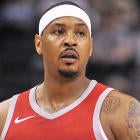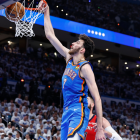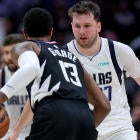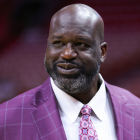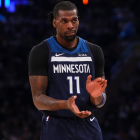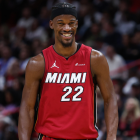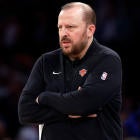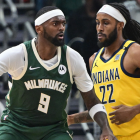Carmelo Anthony, fresh off signing his one-year, non-guaranteed deal with the Trail Blazers worth a reported $2.15 million, is expected to make his Portland debut Tuesday night in New Orleans as a member of the Blazers' starting lineup. The Blazers are on a back-to-back after falling to the Houston Rockets on Monday, while the banged-up Pelicans are coming off a victory against the Warriors on Sunday. Here are five things to watch for as Anthony makes his return to the NBA after almost exactly a calendar year on the shelf.
1. Rust and Rest
Anthony hasn't played in an NBA game since Nov. 8 of last year. He's going to be rusty. He's going to need rest. Anthony is starting the game, and is expected to play about 20 minutes, according to a report from Marc J. Spears of ESPN, but how long can he go for in each stint? The Pelicans play at the third-fastest pace in the league. As the old saying goes, you can work out and "stay in shape" all you want, but you can't simulate real-game action. Melo is going to be gasping early and often.
As for the rust, there are degrees to this. He could look completely out of sync or he could just be a little slow. Fortunately, the Blazers don't run all that intricate an offensive system that relies on a ton of player familiarity and chemistry. They isolate more often than any team in the league except the Rockets. As he eases his way into shape and rhythm, Carmelo can just space the floor from the corner for Damian Lillard and CJ McCollum, and isolate a few times himself -- his bread and butter.
2. Whose minutes will Melo take?
Probably a handful from both Mario Hezonja and Anthony Tolliver, who together are averaging just under 40 minutes a night. My guess is Terry Stotts will try to allocate about half those minutes, with maybe some of Skal Labissiere's time sprinkled in, to Melo at the power forward spot.
Scouts who've spoken with CBS Sports are most intrigued by Melo playing the four, where the Blazers are hugely shorthanded with Zach Collins out until probably at least the All-Star break. Rookie Nassir Little has been starting at the four out of necessity, and he's looked pretty good, particularly with his energy and defense -- two things Melo will not bring to the table. Chances are, Little's minutes will go largely untouched by Anthony.
3. How bad will Melo be defensively?
This is the biggest -- and in many ways the only -- question surrounding Melo's return. If he is a complete disaster defensively and teams are able to target him over and over and yield easy scores, nothing else will matter. Melo will be largely unplayable.
But that might not become a full-blown issue until playoff time, if the Blazers make it that far and Melo is even still around. His contract doesn't become guaranteed until Jan. 7. Until then, the Blazers can cut him loose at any time and not pay him another dime.
The last time we saw Anthony in the NBA, he was getting cooked defensively. He had no ability to switch and guard even halfway effectively on the perimeter with the Rockets, which was the main reason he lasted only 10 games with them. The season before that, Melo was targeted so mercilessly in the playoffs by the Jazz that it was hard to even watch. He had no business being on the floor.
The Blazers will surely try to surround Melo with as many switchable defenders as possible to cover for him -- namely Little and Kent Bazemore. Lineups with Hassan Whiteside will give Melo some rim coverage but will be pretty vulnerable to pick-and-rolls with two guys who can be targeted in switches.
This is Stotts' greatest challenge. Devise some kind of scheme, some kind of lineup(s), some kind of sorcery, whatever it takes to make Carmelo at least somewhat functional on the defensive end. If that can't happen, this isn't going to work for very long unless Anthony is just so lights out offensively that the trade-off adds up. Which brings us to ...
4. How good can Melo be offensively?
Clearly we're looking at this relatively and within his role. Melo is not going to be 20-point-per-game threat. But if he can get even 12-15 points on given nights and shoot somewhere around 35 percent from 3, that will be really valuable for a Blazers team that HAS TO take some pressure off Lillard and McCollum, who are first and third in the league in minutes per game, respectively, and are being asked to do so much to carry a clearly flawed team.
Again, the scouts and league execs I've spoken with love the idea of Melo as a stretch four alongside Lillard and McCollum. This isn't anything new. People have been dreaming on "Olympic Melo" for years, and that player has never come to fruition in the NBA. But the ingredients are there in Portland.
Not only can Melo stretch the floor as a corner 3-point shooter, but in theory he could be a pick-and-pop guy with Lillard, who can use whatever release valve he can find to punish the blitzes and traps teams throw his way. One pass over the top to Melo for an open 3, if that shot is going in, could provide at least some relief from teams being so aggressive with their double teams.
5. Speeding up the acclimation process
Pay attention to this. How early will Stotts get Anthony into the game? How intent will Lillard be in getting him the ball? Will Stotts design a few plays specifically to isolate Melo or pop him open for an elbow jumper?
The bottom line is this is not a courtesy signing for a one-time great player who wanted back in the league. The Blazers need Melo to be good, and they need him to be good as close to right away as possible. They're already 5-9 and looking straight up at the playoff race. Lose too much ground in the West, and you're not going to recover.
It is in the Blazers' interest to prioritize Melo's rhythm to whatever extent they can without compromising their chances of winning. That's a fine line to walk. Lillard is the superstar and the point guard, and it'll largely be on him to manage the team and Melo's role within it until Anthony finds his own groove, which needs to happen before it's too late to matter.













